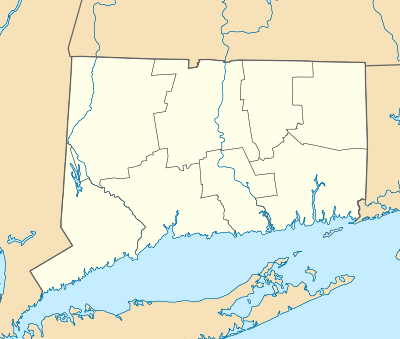First Church of Christ, Congregational (Farmington, Connecticut)
The First Church of Christ, Congregational is a historic church at 75 Main Street in Farmington, Connecticut. Built in 1771, this Greek Revival church was designated a National Historic Landmark in 1975 for its role in sheltering the Amistad Africans before their return to Africa.
First Church of Christ, Congregational | |
 | |
  | |
| Location | 75 Main Street, Farmington, Connecticut 06032 |
|---|---|
| Coordinates | 41°43′14.14″N 72°49′47.05″W |
| Built | 1771 |
| Architect | Judah Woodruff |
| Architectural style | Greek Revival |
| Part of | Farmington Historic District (ID72001331) |
| NRHP reference No. | 75002056 |
| Significant dates | |
| Added to NRHP | May 15, 1975[1] |
| Designated NHL | May 15, 1975[2] |
| Designated CP | March 17, 1972 |
Description and history
The First Church of Christ in Farmington was founded in 1652. Roger Newton, the first pastor, was the son-in-law of Hartford founder Thomas Hooker, and was succeeded by Hooker's son, Samuel. Among First Church's pastors was Noah Porter, who began America's first foreign missionary society in the parlor of his home. He was also the father of Sarah Porter, founder of Miss Porter's School, and Noah Porter, Jr., president of Yale University.
The present church, the third, originally known as the Meeting House, was built in 1771, designed by Judah Woodruff. The slender steeple on top of the bell tower can be seen for miles. The church is cited as an "excellent example of its architectural style and period".[3]
The church began the first "Sabbath School" in the 1700s for the local Tunxis Indians, to teach them Christianity. It was a hub of the Underground Railroad, and became involved in the celebrated case of the African slaves who revolted on the Spanish vessel La Amistad. When the Africans who had participated in the revolt were released in 1841, they came to Farmington, and stayed with Austin Williams before their return to Africa.[4] While staying in Farmington, they attended this church. The Amistad case was important for the abolitionist cause and significant in the history of slavery in the United States.
The church was declared a National Historic Landmark in 1975.[2][3] It is included in the Farmington Historic District.
First Church is affiliated with the United Church of Christ.
See also
- First Church of Christ, Congregational (disambiguation)
- List of National Historic Landmarks in Connecticut
- National Register of Historic Places listings in Hartford County, Connecticut
References
- "National Register Information System". National Register of Historic Places. National Park Service. January 23, 2007.
- "First Church of Christ". National Historic Landmark summary listing. National Park Service. Archived from the original on 2007-10-12. Retrieved 2007-10-03.
- Greenlee, Marcia M. (September 27, 1974). "National Register of Historic Places Inventory-Nomination: First Church of Christ, Congregational" (pdf). National Park Service. Retrieved 30 July 2013. Cite journal requires
|journal=(help) and "Accompanying 6 photos, exterior and interior, from 1967 and 1974" (pdf). Retrieved 30 July 2013. Cite journal requires|journal=(help) - Cunningham, Jan (September 15, 1996). "National Historic Landmark Nomination: Austin F. Williams Carriagehouse and House" (pdf). National Park Service. Cite journal requires
|journal=(help) and Accompanying 10 photos, exterior and interior, from 1996 and undated (3.49 MB)
External links
| Wikimedia Commons has media related to First Church of Christ, Congregational (Farmington, Connecticut). |

